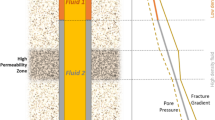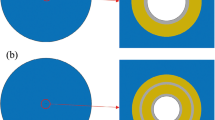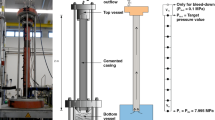Abstract
In the process of plugging wellbore with balanced plugging mud, hydration reaction kinetics, heat transfer and fluid mechanics interact with each other during the cement plugging stage, forming a complex physical and chemical process, which has not been fully taken into account in the current mechanical model of abandoned wellbore. Based on this, firstly, considering the hydration of cement plug during solidification stage, a transient heat-fluid-chemical coupling model of the abandoned wellbore is established. Then, the implicit finite difference method is used to discretized solve the simultaneous equations, and the characteristics of temperature distribution, hydration law of cement plug and pressure distribution of the abandoned wellbore are analyzed. The results show that the temperature of deep cement plug is almost constant after reaching the peak value under the coupling effect of thermal-fluid-chemical interaction, the temperature of shallow cement plug decreased significantly (by about 8 ℃) and the middle cement plug was followed by a reduction of about 5 ℃. The porosity and pore pressure of deep cement plug decreased rapidly, followed by the middle cement plug, and the shallow cement plug was the slowest. The hydration degree, gel strength and chemical shrinkage rate of the deep cement plug increased rapidly, followed by the middle cement plug, and the shallow cement plug was relatively slow.
Access provided by Autonomous University of Puebla. Download conference paper PDF
Similar content being viewed by others
Keywords
1 Introduction
The traditional wellbore disposal adopts the balanced plug filling method, which can be divided into circulating drilling fluid stage, cement plug filling stage, slurry displacing stage, drilling and well washing stage and waiting stage [1, 2]. The cement plug needs to inject the mixed cement slurry into the drilling tool or (tubing) according to the designed amount. The cement slurry is made by mixing dry cement with water and additives in a certain proportion. The mixed cement slurry immediately reacts with hydration, and the main process of the hydration reaction of the cement slurry occurs in the waiting setting stage. In the waiting stage, hydration reaction kinetics, heat transfer and fluid mechanics interact with each other to form a complex physico-chemical process that jointly affects the development and change of stress in the abandoned wellbore. However, the current mechanical model of the abandoned wellbore has not taken this complex physico-chemical process into account. Based on this, the transient heat-fluid-chemical coupling model of abandoned wellbore is established and solved, and the distribution law of wellbore temperature, cement plug hydration degree and cement plug pressure in the physical and chemical process of cement plug plugging wellbore is described, providing a reference for the establishment of wellbore mechanical model.
2 Transient Thermal-Fluid-Chemical Coupling Model of Abandoned Wellbore
2.1 Model Assumptions
-
(1)
The hydration reaction starts from the waiting stage and ignores the hydration reaction in other stages;
-
(2)
In the process of circulating drilling fluid, cementing plug and slurry displacing, the fluid flow in the wellbore is one-dimensional along the direction of the wellbore, regardless of the radial direction of the flow;
-
(3)
Considering the influence of friction heat generation between fluid and string, other heat source terms are ignored;
-
(4)
Ignore the influence of temperature on thermal property parameters such as thermal conductivity, specific heat and viscosity.
2.2 Dynamic Equation of Cement Hydration Reaction
-
(1)
Kinetic principle of hydration reaction
For the heterogeneous material system under non-isothermal conditions, the kinetic equation of chemical reaction can be obtained [3, 4]:
-
(2)
Kinetics model of hydration reaction [5, 6]
$$ \frac{d\alpha }{{dt}} = K_{NG} l\left( {1 - \alpha } \right)\left[ { - ln\left( {1 - \alpha } \right)} \right]^{{{{\left( {l - 1} \right)} \mathord{\left/ {\vphantom {{\left( {l - 1} \right)} l}} \right. \kern-0pt} l}}} $$(2)$$ \frac{d\alpha }{{dt}} = 3K_{I} \left( {1 - \alpha } \right)^{{{2 \mathord{\left/ {\vphantom {2 3}} \right. \kern-0pt} 3}}} $$(3)$$ \frac{d\alpha }{{dt}} = \frac{3}{2}K_{D} \left( {1 - \alpha } \right)^{{{2 \mathord{\left/ {\vphantom {2 3}} \right. \kern-0pt} 3}}} /\left[ {1 - \left( {1 - \alpha } \right)^{{{1 \mathord{\left/ {\vphantom {1 3}} \right. \kern-0pt} 3}}} } \right] $$(4)
2.3 Heat Transfer Equation
-
(1)
Heat transfer equation in tubing during fluid movement [7,8,9,10]
$$ \frac{1}{{v_{c} }}\frac{{\partial T_{c} }}{\partial t} + \frac{{\partial T_{c} }}{\partial z} = \frac{{2\pi r_{ci} U_{c} }}{{c_{f} A_{c} v_{c} \rho_{f} }}\left( {T_{a} - T_{c} } \right) + \frac{{p_{c} }}{{c_{f} \rho_{f} }} $$(5) -
(2)
Heat transfer equation in annulus during fluid movement
$$ \frac{1}{{v_{a} }}\frac{{\partial T_{a} }}{\partial t} - \frac{{\partial T_{a} }}{\partial z} = \frac{{2\pi r_{w} h_{a} }}{{c_{f} A_{a} v_{a} \rho_{f} }}\left( {T_{e,0} - T_{a} } \right) - \frac{{2\pi r_{ci} h_{c} }}{{c_{f} A_{a} v_{a} \rho_{f} }}\left( {T_{a} - T_{c} } \right) + \frac{{p_{a} }}{{c_{f} \rho_{f} }} $$(6) -
(3)
Heat transfer equation in casing during static fluid process
$$ \frac{{\partial T_{cs} }}{\partial t} = \frac{{Q_{\max } }}{{c_{c} }}\frac{\partial \alpha }{{\partial t}} + \frac{{2\pi r_{w} h_{a} }}{{c_{c} \rho_{c} A_{cs} }}\left( {T_{e,0} - T_{cs} } \right){ + }\frac{{k_{c} }}{{c_{c} \rho_{c} }}\frac{{\partial^{2} T_{cs} }}{{\partial z^{2} }} $$(7) -
(4)
Formation heat transfer equation
$$ \frac{{\rho_{e} c_{e} }}{{k_{e} }}\frac{{\partial T_{e} }}{\partial t} = \frac{{\partial T_{e}^{2} }}{{\partial r^{2} }} + \frac{1}{r}\frac{{\partial T_{e} }}{\partial r} $$(8)
-
(5)
Auxiliary equation
The comprehensive heat transfer coefficient hc between the fluid in the tubing and the fluid in the annulus is expressed as:
The comprehensive heat transfer coefficient ha between annulus fluid and borehole wall can be expressed as:
2.4 Pressure Field Equation of Cement Plug
The final equation for calculating the pore pressure of cement plug is:
3 Calculation and Analysis of Transient Heat-Fluid-Chemical Coupling Model of Abandoned Wellbore
3.1 Model Solving and Verification
The partial differential equations were discretized by an unconditional and stable Crank Nicolson implicit numerical scheme, and the time and space grids in the cement hydration dynamics equation, thermodynamic equation and cement plug pressure field equation were consistent. Two-point difference scheme is used for the derivatives of first order time and first order space, and three-point central difference scheme is used for the derivatives of second order time and second order space.
In order to verify the reliability of the model, the heat-fluid-chemical coupling model established in this paper was applied to the experiment of Nagelhout et al., the environment temperature was set at 60 °C, and other calculation parameters in the model could be obtained from relevant literature [11]. As can be seen from Fig. 1, the temperature calculated by the model in the cement plug solidification process is in good agreement with the temperature development trend measured by experiments, indicating that the heat-fluid-chemical coupling model established in this paper has high accuracy and can meet the requirements of subsequent calculation and simulation.
3.2 Analysis of Calculation Results
3.2.1 Wellbore Temperature Distribution Characteristics
A simulated well was selected as the research object. Firstly, the transient heat-fluid-chemical coupling model was used to simulate the cementing plug in the whole wellbore of the well, and the temperature changes of the wellbore and formation during the circulating drilling fluid stage and cement plug setting process were analyzed. The position of the mud line is 50 m, and the geothermal gradient is 3 °C/100 m. The basic input parameters in the model are shown in Table 1.
The well interval of 1950–2100 m, 1050–1150 m and 150–250 m of the simulated well were selected as the research object, and the length of cement plug was 150 m, 100 m and 100 m, respectively. The established model was used for simulation calculation. The change of wellbore temperature, hydration rule of cement plug and change of cement plug pressure during cement plug setting were quantitatively analyzed.
Figure 2 shows the change of cement plug temperature at different depths with time. Due to hydration reaction and large amount of heat generated by cement plug in the waiting stage, the temperature of cement plug rapidly rises and reaches a peak value. In this process, heat is exchanged between cement plug and surrounding wellbore and formation. The temperature decreased significantly (about 8 ℃) from the peak.
3.2.2 Hydration Law of Cement Plug
Figure 3 shows the change of hydration degree of cement plug with time at different depths. It can be seen from the figure that hydration degree increases with the increase of waiting time in cement plug setting stage. The hydration degree of cement plug with deep position in the stage of cement plug waiting for setting increases rapidly and is close to 100%. The high temperature environment can accelerate the hydration reaction process of cement plug and shorten the setting time of cement plug. However, the hydration rate of cement plug in shallow layer is relatively slow, and it takes a long waiting time to reach the solidification state.
Figure 4 shows the change of chemical shrinkage rate of cement plug at different depths over time. It can be seen from the figure that the chemical shrinkage rate of cement plug at the stage of waiting for setting gradually increases with the increase of time, and the chemical shrinkage rate of cement plug at the shallow position is significantly lower than that at the deep position.
Figure 5 shows the change of cementing strength of cement plug at different depths with time. It can be seen from the figure that gel strength of cement plug increases with the increase of time. The gel strength of the cement plug in the deep position increases faster than that in the shallow position during the solidification process, which means that the cement plug in the deep position preferentially loses plasticity to reach the final setting under the action of high temperature and high pressure, and has a certain compressive strength.
3.2.3 Cement Plug Pressure Distribution Characteristics
Figure 6 shows the change of porosity of cement plug with time at different depths. It can be seen from the figure that the porosity of cement plug decreases with the increase of time. The porosity of the deep cement plug is smaller and decreases faster than that of the shallow cement plug during the setting process.
Figure 7 shows the change of pore pressure of cement plug with time at different depths. It can be seen from the figure that pore pressure of cement plug decreases and eventually becomes stable with the increase of time. Compared with the cement plug at the shallow position, the pore pressure of the cement plug at the deep position decreased significantly at the beginning of the setting process.
4 Conclusions
-
(1)
Considering hydration of cement plug during solidification stage, a transient heat-fluid-chemical coupling model of abandoned wellbore is established. The implicit finite difference method is used to discretely solve the simultaneous equations, and the characteristics of temperature distribution, cement plug hydration law and cement plug pressure distribution of abandoned wellbore are analyzed.
-
(2)
Under the coupling action of heat-fluid-chemical, the temperature of deep cement plug is almost constant after reaching the peak, the temperature of shallow cement plug decreased significantly (by about 8 ℃) and the middle cement plug was followed by a reduction of about 5 ℃. The porosity and pore pressure of deep cement plug decreased rapidly, followed by the middle cement plug, and the shallow cement plug was the slowest. The hydration degree, gel strength and chemical shrinkage rate of the deep cement plug increased rapidly, followed by the middle cement plug, and the shallow cement plug was relatively slow.
References
Liu, D., Tian X.: Modern Cementing Techniques, pp. 352–355. Liaoning Science and Technology Press, Shenyang (1994)
Liu, C., Huang B., Xu T., et al.: Theory and Application of Cementing in Oil and Gas Wells, pp. 453–455. Petroleum Industry Press, Beijing (2001)
Krstulovic, R., Dabic, P.: A conceptual model of the cement hydration process. Cem. Concr. Res. 30(5), 693–698 (2000)
Pang, X., Jimenez, W.C., Iverson, B.J.: Hydration kinetics modeling of the effect of curing temperature and pressure on the heat evolution of oil well cement. Cem. Concr. Res. 54, 69–76 (2013)
Parcevaux, P.A.: Pore size distribution of portland cement slurries at very early stage of hydration (influence of curing temperature and pressure). Cem. Concr. Res. 14(3), 419–430 (1984)
Lin, F., Meyer, C.: Hydration kinetics modeling of Portland cement considering the effects of curing temperature and applied pressure. Cem. Concr. Res. 39(4), 255–265 (2009)
Sun, B., Wang, X., Wang, Z., et al.: Transient temperature calculation method for deep-water cementing based on hydration kinetics model. Appl. Therm. Eng. 129, 1426–1434 (2017)
Wang, X., Wang, Z., Deng, X., et al.: Coupled thermal model of wellbore and permafrost in Arctic regions. Appl. Therm. Eng. 123, 1291–1299 (2017)
Wang, X., Sun, B., Li, S., et al.: Numerical modeling of hydration performance for well cement exposed to a wide range of temperature and pressure. Constr. Build. Mater. 261, 119929 (2020)
Wang, X., Shen, H., Sun, B., et al.: Mechanism of gas migration through microstructure of cemented annulus in deep-water environment. J. Nat. Gas Sci. Eng. 78, 103316 (2020)
Jiang, J., Li, J., Liu, G., et al.: Numerical simulation investigation on fracture debonding failure of cement plug/casing interface in abandoned wells. J. Petrol. Sci. Eng. 192, 107226 (2020)
Author information
Authors and Affiliations
Corresponding author
Editor information
Editors and Affiliations
Rights and permissions
Copyright information
© 2024 The Author(s), under exclusive license to Springer Nature Switzerland AG
About this paper
Cite this paper
Jiang, J. et al. (2024). Numerical Simulation Research on Transient Thermal-Fluid-Chemical Coupling of Abandoned Wellbore. In: Li, S. (eds) Computational and Experimental Simulations in Engineering. ICCES 2023. Mechanisms and Machine Science, vol 146. Springer, Cham. https://doi.org/10.1007/978-3-031-44947-5_85
Download citation
DOI: https://doi.org/10.1007/978-3-031-44947-5_85
Published:
Publisher Name: Springer, Cham
Print ISBN: 978-3-031-44946-8
Online ISBN: 978-3-031-44947-5
eBook Packages: EngineeringEngineering (R0)











